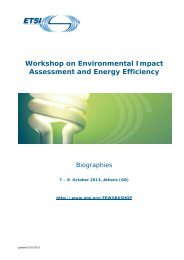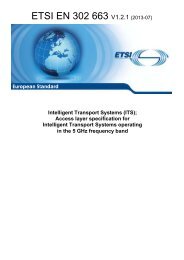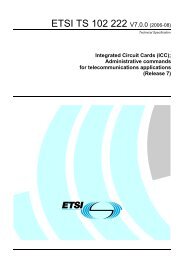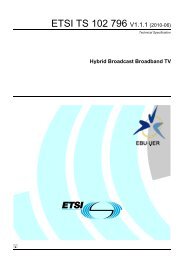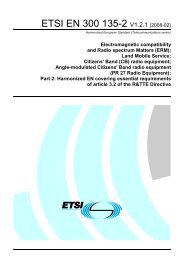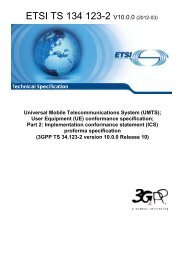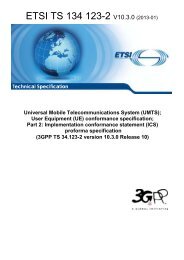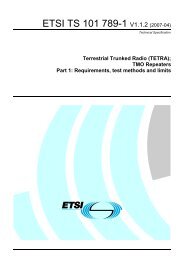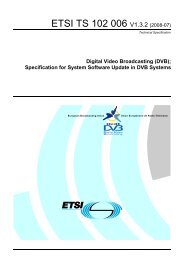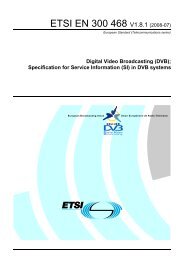EN 301 775 - V1.2.1 - Digital Video Broadcasting (DVB ... - ETSI
EN 301 775 - V1.2.1 - Digital Video Broadcasting (DVB ... - ETSI
EN 301 775 - V1.2.1 - Digital Video Broadcasting (DVB ... - ETSI
Create successful ePaper yourself
Turn your PDF publications into a flip-book with our unique Google optimized e-Paper software.
<strong>ETSI</strong> <strong>EN</strong> <strong>301</strong> <strong>775</strong> <strong>V1.2.1</strong> (2003-05)<br />
European Standard (Telecommunications series)<br />
<strong>Digital</strong> <strong>Video</strong> <strong>Broadcasting</strong> (<strong>DVB</strong>);<br />
Specification for the carriage of Vertical Blanking<br />
Information (VBI) data in <strong>DVB</strong> bitstreams<br />
European <strong>Broadcasting</strong> Union Union Européenne de Radio-Télévision<br />
EBU·UER
2<br />
Reference<br />
R<strong>EN</strong>/JTC-<strong>DVB</strong>-144<br />
Keywords<br />
broadcasting, digital, <strong>DVB</strong>, SNG, TV, video<br />
<strong>ETSI</strong><br />
650 Route des Lucioles<br />
F-06921 Sophia Antipolis Cedex - FRANCE<br />
Tel.: +33 4 92 94 42 00 Fax: +33 4 93 65 47 16<br />
Siret N° 348 623 562 00017 - NAF 742 C<br />
Association à but non lucratif enregistrée à la<br />
Sous-Préfecture de Grasse (06) N° 7803/88<br />
Important notice<br />
Individual copies of the present document can be downloaded from:<br />
http://www.etsi.org<br />
<strong>ETSI</strong><br />
<strong>ETSI</strong> <strong>EN</strong> <strong>301</strong> <strong>775</strong> <strong>V1.2.1</strong> (2003-05)<br />
The present document may be made available in more than one electronic version or in print. In any case of existing or<br />
perceived difference in contents between such versions, the reference version is the Portable Document Format (PDF).<br />
In case of dispute, the reference shall be the printing on <strong>ETSI</strong> printers of the PDF version kept on a specific network drive<br />
within <strong>ETSI</strong> Secretariat.<br />
Users of the present document should be aware that the document may be subject to revision or change of status.<br />
Information on the current status of this and other <strong>ETSI</strong> documents is available at<br />
http://portal.etsi.org/tb/status/status.asp<br />
If you find errors in the present document, send your comment to:<br />
editor@etsi.org<br />
Copyright Notification<br />
No part may be reproduced except as authorized by written permission.<br />
The copyright and the foregoing restriction extend to reproduction in all media.<br />
© European Telecommunications Standards Institute 2003.<br />
© European <strong>Broadcasting</strong> Union 2003.<br />
All rights reserved.<br />
DECT TM , PLUGTESTS TM and UMTS TM are Trade Marks of <strong>ETSI</strong> registered for the benefit of its Members.<br />
TIPHON TM and the TIPHON logo are Trade Marks currently being registered by <strong>ETSI</strong> for the benefit of its Members.<br />
3GPP TM is a Trade Mark of <strong>ETSI</strong> registered for the benefit of its Members and of the 3GPP Organizational Partners.
Contents<br />
3<br />
<strong>ETSI</strong><br />
<strong>ETSI</strong> <strong>EN</strong> <strong>301</strong> <strong>775</strong> <strong>V1.2.1</strong> (2003-05)<br />
Intellectual Property Rights................................................................................................................................4<br />
Foreword.............................................................................................................................................................4<br />
1 Scope ........................................................................................................................................................5<br />
2 References ................................................................................................................................................5<br />
3 Abbreviations ...........................................................................................................................................6<br />
4 Coding of VBI Signals in MPEG-2 Transport Streams ...........................................................................6<br />
4.1 General issues.....................................................................................................................................................6<br />
4.2 Definition of SI for VBI data streams ................................................................................................................7<br />
4.3 PES packet format..............................................................................................................................................7<br />
4.4 Definition of PES data field ...............................................................................................................................7<br />
4.4.1 Syntax for PES data field..............................................................................................................................8<br />
4.4.2 Semantics for PES data field.........................................................................................................................8<br />
4.5 Data field for EBU and Inverted Teletext ..........................................................................................................9<br />
4.5.1 Syntax for EBU and Inverted Teletext data field..........................................................................................9<br />
4.5.2 Semantics for EBU and Inverted Teletext data field ....................................................................................9<br />
4.6 Data field for VPS ............................................................................................................................................10<br />
4.6.1 Syntax for VPS data field ...........................................................................................................................10<br />
4.6.2 Semantics for VPS data field ......................................................................................................................10<br />
4.7 Data field for WSS ...........................................................................................................................................11<br />
4.7.1 Syntax for WSS data field ..........................................................................................................................11<br />
4.7.2 Semantics for WSS data field .....................................................................................................................11<br />
4.8 Data field for Closed Captioning......................................................................................................................12<br />
4.8.1 Syntax for Closed Captioning data field.....................................................................................................12<br />
4.8.2 Semantics for Closed Captioning data field................................................................................................12<br />
4.9 Data field for monochrome 4:2:2 samples .......................................................................................................12<br />
4.9.1 Syntax for monochrome data field..............................................................................................................13<br />
4.9.2 Semantics for monochrome data field ........................................................................................................13<br />
4.10 Combining VBI data with <strong>EN</strong> 300 472 Teletext data.......................................................................................14<br />
Annex A (informative): Bibliography...................................................................................................15<br />
History ..............................................................................................................................................................16
Intellectual Property Rights<br />
4<br />
<strong>ETSI</strong><br />
<strong>ETSI</strong> <strong>EN</strong> <strong>301</strong> <strong>775</strong> <strong>V1.2.1</strong> (2003-05)<br />
IPRs essential or potentially essential to the present document may have been declared to <strong>ETSI</strong>. The information<br />
pertaining to these essential IPRs, if any, is publicly available for <strong>ETSI</strong> members and non-members, and can be found<br />
in <strong>ETSI</strong> SR 000 314: "Intellectual Property Rights (IPRs); Essential, or potentially Essential, IPRs notified to <strong>ETSI</strong> in<br />
respect of <strong>ETSI</strong> standards", which is available from the <strong>ETSI</strong> Secretariat. Latest updates are available on the <strong>ETSI</strong> Web<br />
server (http://webapp.etsi.org/IPR/home.asp).<br />
All published <strong>ETSI</strong> deliverables shall include information which directs the reader to the above source of information.<br />
Foreword<br />
This European Standard (Telecommunications series) has been produced by Joint Technical Committee (JTC)<br />
Broadcast of the European <strong>Broadcasting</strong> Union (EBU), Comité Européen de Normalisation ELECtrotechnique<br />
(C<strong>EN</strong>ELEC) and the European Telecommunications Standards Institute (<strong>ETSI</strong>).<br />
NOTE: The EBU/<strong>ETSI</strong> JTC Broadcast was established in 1990 to co-ordinate the drafting of standards in the<br />
specific field of broadcasting and related fields. Since 1995 the JTC Broadcast became a tripartite body<br />
by including in the Memorandum of Understanding also C<strong>EN</strong>ELEC, which is responsible for the<br />
standardization of radio and television receivers. The EBU is a professional association of broadcasting<br />
organizations whose work includes the co-ordination of its members' activities in the technical, legal,<br />
programme-making and programme-exchange domains. The EBU has active members in about<br />
60 countries in the European broadcasting area; its headquarters is in Geneva.<br />
European <strong>Broadcasting</strong> Union<br />
CH-1218 GRAND SACONNEX (Geneva)<br />
Switzerland<br />
Tel: +41 22 717 21 11<br />
Fax: +41 22 717 24 81<br />
Founded in September 1993, the <strong>DVB</strong> Project is a market-led consortium of public and private sector organizations in<br />
the television industry. Its aim is to establish the framework for the introduction of MPEG-2 based digital television<br />
services. Now comprising over 200 organizations from more than 25 countries around the world, <strong>DVB</strong> fosters<br />
market-led systems, which meet the real needs, and economic circumstances, of the consumer electronics and the<br />
broadcast industry.<br />
National transposition dates<br />
Date of adoption of this <strong>EN</strong>: 23 May 2003<br />
Date of latest announcement of this <strong>EN</strong> (doa): 31 August 2003<br />
Date of latest publication of new National Standard<br />
or endorsement of this <strong>EN</strong> (dop/e):<br />
29 February 2004<br />
Date of withdrawal of any conflicting National Standard (dow): 29 February 2004
1 Scope<br />
5<br />
<strong>ETSI</strong><br />
<strong>ETSI</strong> <strong>EN</strong> <strong>301</strong> <strong>775</strong> <strong>V1.2.1</strong> (2003-05)<br />
The present document specifies a new VBI standard to be added to MPEG-2 and <strong>DVB</strong> to handle the transmission of<br />
data intended to be transcoded into the VBI of MPEG-2 decoded video. The definitions given by the present document<br />
are an extension of the format specified by <strong>EN</strong> 300 472 [2].<br />
The extensions include Inverted Teletext, VPS (<strong>EN</strong> 300 231 [4]) and WSS (<strong>EN</strong> 300 294 [5]) data to be used for<br />
625-line systems and Closed-Captioning (EIA-608 Revision A [6]) data to be used for 525-line systems. Also, a generic<br />
format for transmitting luminance-only VBI data is defined to have a means of coping with other standard or<br />
non-standard VBI systems.<br />
The present document allows for conveying VBI data units and EBU Teletext data units using the same elementary<br />
stream. Backwards compliance with the <strong>EN</strong> 300 472 [2] is guaranteed, as the EBU Teletext as specified in<br />
<strong>EN</strong> 300 472 [2] and VBI data as specified in the present document can co-exist in the same service on separate PIDs.<br />
To cater for this, some extensions to the SI, <strong>EN</strong> 300 468 [9] have been defined.<br />
2 References<br />
The following documents contain provisions which, through reference in this text, constitute provisions of the present<br />
document.<br />
• References are either specific (identified by date of publication and/or edition number or version number) or<br />
non-specific.<br />
• For a specific reference, subsequent revisions do not apply.<br />
• For a non-specific reference, the latest version applies.<br />
Referenced documents which are not found to be publicly available in the expected location might be found at<br />
http://docbox.etsi.org/Reference.<br />
[1] ISO/IEC 13818-1: "Information technology - Generic coding of moving pictures and associated<br />
audio information: Systems".<br />
[2] <strong>ETSI</strong> <strong>EN</strong> 300 472: "<strong>Digital</strong> <strong>Video</strong> <strong>Broadcasting</strong> (<strong>DVB</strong>); Specification for conveying ITU-R<br />
System B Teletext in <strong>DVB</strong> bitstreams".<br />
[3] <strong>ETSI</strong> <strong>EN</strong> 300 706: "Enhanced Teletext Specification".<br />
[4] <strong>ETSI</strong> <strong>EN</strong> 300 231: "Television systems; Specification of the domestic video Programme Delivery<br />
Control system (PDC)".<br />
[5] <strong>ETSI</strong> <strong>EN</strong> 300 294: "Television systems; 625-line television Wide Screen Signalling (WSS)".<br />
[6] EIA-608 Revision A: "Recommended practice for Line 21 data service".<br />
[7] ITU-R Recommendation BT.601-1: "Encoding parameters of digital television for studios".<br />
[8] ITU-R Recommendation BT.656: "Interfaces for digital component video signals in 525-line and<br />
625-line television systems operating at the 4:2:2 level of Recommendation ITU-R BT.601<br />
(Part A)".<br />
[9] <strong>ETSI</strong> <strong>EN</strong> 300 468: "<strong>Digital</strong> <strong>Video</strong> <strong>Broadcasting</strong> (<strong>DVB</strong>); Specification for Service Information (SI)<br />
in <strong>DVB</strong> systems".
3 Abbreviations<br />
For the purposes of the present document, the following abbreviations apply:<br />
CC Closed Captioning<br />
<strong>DVB</strong> <strong>Digital</strong> <strong>Video</strong> <strong>Broadcasting</strong><br />
EACEM European Association of Consumer Electronics Manufacturers<br />
EBU European <strong>Broadcasting</strong> Union<br />
EIA Electronic Industries Association<br />
ETS European Telecommunication Standard<br />
<strong>ETSI</strong> European Telecommunications Standards Institute<br />
IEC International Electrotechnical Commission<br />
ISO International Standards Organization<br />
ITU International Telecommunications Union<br />
MPEG Moving Pictures Experts Group<br />
PES Packetized Elementary Stream<br />
PID Packet Identifier<br />
PMT Program Map Table<br />
PSI Program Specific Information<br />
PTS Presentation Time Stamp<br />
SI Service Information<br />
VBI Vertical Blanking Interval<br />
VPS <strong>Video</strong> Programme System<br />
WSS Wide Screen Signalling<br />
6<br />
<strong>ETSI</strong><br />
<strong>ETSI</strong> <strong>EN</strong> <strong>301</strong> <strong>775</strong> <strong>V1.2.1</strong> (2003-05)<br />
4 Coding of VBI Signals in MPEG-2 Transport Streams<br />
4.1 General issues<br />
The VBI data transferred through the mechanism described in this clause is intended to be transcoded into the VBI of a<br />
companion video channel of an MPEG-2 programme. However, it also is possible to transmit and transcode a VBI data<br />
stream on its own, without a companion video channel. In addition it is possible for a decoder to interpret the data<br />
directly, without any intermediate transcoding into the VBI.<br />
The transmission means is generally based on <strong>EN</strong> 300 472 [2]. The data transfer uses the private PES packet<br />
mechanism of type private_stream_1 as defined by ISO/IEC 13818-1 [1]. The VBI encoding and decoding should be<br />
synchronized with the companion video channel, if one is present.<br />
The VBI data stream associated with a service is identified in the Program Map Table (PMT) of the Program Specific<br />
Information (PSI) for that service. This mechanism is described in clause 4.2.<br />
The following restrictions apply to the coding of VBI data as described in the present document:<br />
- a VBI PES packet contains data of one and only one video frame and always carries a PTS;<br />
- the decoding of VBI data does not require a frame memory (i.e. a memory that stores VBI data for display in a<br />
frame other than the current). This means that VBI data present for a certain line within a certain frame never<br />
will appear in the next frame unless it is specifically coded as such again;<br />
- the VBI decoding does not require a line memory (i.e. a memory that stores one or more lines of VBI data for<br />
display in the current frame). This means that lines shall appear in the bitstream in the same order, as they will<br />
appear in the VBI;<br />
- VBI lines that are not coded will either be set to "black" or will have another default value defined by the<br />
decoder;<br />
- a certain VBI line may never be coded twice within a frame. A line is coded using one and only one data field<br />
with the exception of lines containing monochrome 4:2:2 samples (see clause 4.9). These may be spread over<br />
several data fields adjacently coded;
7<br />
<strong>ETSI</strong><br />
<strong>ETSI</strong> <strong>EN</strong> <strong>301</strong> <strong>775</strong> <strong>V1.2.1</strong> (2003-05)<br />
- whenever a VBI stream is coded, the VBI_data_descriptor defined in clause 4.2 shall be used in the PMT to<br />
identify the VBI stream. If Teletext is coded in the same stream, then at the same time a VBI Teletext<br />
descriptor shall be associated with the VBI stream;<br />
- the data_identifier defined in clause 4.4 shall be set to either 0x10 to 0x1F or 0x99 to 0x9B. For data_identifier<br />
values between 0x10 to 0x1F, it may be possible that decoders compliant only to <strong>EN</strong> 300 472 [2] are able to<br />
decode the Teletext data. They have to be robust against the non-teletext data; i.e. robust against data units<br />
other than 0x02, 0x03, and 0xFF;<br />
- the standard Teletext buffer model is used, as is defined by <strong>EN</strong> 300 472 [2].<br />
4.2 Definition of SI for VBI data streams<br />
The Packet Identifier (PID) of a VBI data stream associated with a service is identified in the Program Map Table<br />
(PMT) of the Program Specific Information (PSI) for that service. The VBI data stream is given stream_type value<br />
0x06, which indicates a PES stream carrying private data. If the VBI data stream contains any of the extensions defined<br />
by the present document, the appropriate ES_info_field of the program map section describing VBI data streams shall<br />
contain one and only one VBI_data_descriptor as defined in <strong>EN</strong> 300 468 [9]. A service may include more than one VBI<br />
data stream, provided that the streams are distinguishable by their respective descriptors in the PSI. In addition a VBI<br />
Teletext descriptor shall be used if and only if the VBI stream contains amongst others EBU Teletext data. The<br />
descriptor is needed to use languages for selecting magazines or subtitles.<br />
For the component descriptor, VBI data transported using the VBI standard is represented by stream_content and<br />
component_type values defined in <strong>EN</strong> 300 468 [9].<br />
4.3 PES packet format<br />
The standard PES packet syntax and semantics are followed noting the following constraints:<br />
stream_id set to "1011 1101" meaning "private_stream_1".<br />
PES_packet_length set to the value (N × 184) - 6, where N is an integer, so that the PES packet finishes<br />
at the end of a Transport packet.<br />
Data_alignment_indicator set to "1" indicating that the VBI access units are aligned with the PES packets.<br />
PES_header_data_length set to "0x24".<br />
stuffing_byte the PES header is followed by as many stuffing bytes as are required to make up the<br />
header data length, so that the entire PES header is 45 bytes long.<br />
PES_packet_data_byte these bytes are coded in accordance with the PES_data_field syntax specified below.<br />
PTS shall be present and other optional fields may be present in the PES header, but the header length is always fixed<br />
for streams identified in the Program Specific Information (PSI) by the VBI Teletext descriptor and/or the VBI data<br />
descriptor (see <strong>EN</strong> 300 468 [9]).<br />
4.4 Definition of PES data field<br />
The PES data field is defined by PES_data_field in <strong>EN</strong> 300 472 [2], table 1 with the extension of the data field to other<br />
types of data.
4.4.1 Syntax for PES data field<br />
8<br />
Table 1: Syntax for PES data field<br />
<strong>ETSI</strong><br />
<strong>ETSI</strong> <strong>EN</strong> <strong>301</strong> <strong>775</strong> <strong>V1.2.1</strong> (2003-05)<br />
Syntax No. of<br />
bits<br />
Mnem. Valid Range<br />
PES_data_field () {<br />
data_identifier<br />
for (I = 0; i < N; i++) {<br />
8 uimsbf See table 2<br />
data_unit_id 8 uimsbf See table 3<br />
data_unit_length<br />
if (data_unit_id == 0x02 ||<br />
data_unit_id == 0x03 ||<br />
data_unit_id == 0xC0 ||<br />
data_unit_id == 0xC1) {<br />
txt_data_field ();<br />
} else if (data_unit_id == 0xC3) {<br />
vps_data_field();<br />
} else if (data_unit_id == 0xC4) {<br />
wss_data_field ();<br />
} else if (data_unit_id == 0xC5) {<br />
closed_captioning_data_field ();<br />
} else if (data_unit_id == 0xC6) {<br />
monochrome_data_field ();<br />
} else if (data_unit_id == 0xFF) {<br />
/* No data field */<br />
}<br />
for (i = 0; i < N; i++) {<br />
8 uimsbf 0x00 .. 0xFF<br />
stuffing_byte<br />
}<br />
}<br />
}<br />
8 bslbf "11111111"<br />
4.4.2 Semantics for PES data field<br />
The semantics for PES data field from <strong>EN</strong> 300 472 [2] are followed, noting the following additions and constraints:<br />
data_identifier: this 8-bit field identifies the type of data carried in the PES packet. It is coded as in table 2.<br />
data_unit_id: this 8-bit field identifies the type of this data unit. The coding is based on table 4 in <strong>EN</strong> 300 472 [2], with<br />
the addition of a number of reserved values. Coding as defined by the present document is given by table 3.<br />
data_unit_length: this 8-bit field indicates the number of bytes in this data unit immediately following the length field.<br />
If the data_identifier has a value between 0x10 and 0x1F inclusive, this field shall always be set to 0x2C.<br />
stuffing_byte: this 8-bit field shall in any case be discarded by the decoder.<br />
Table 2: data_identifier for PES data field<br />
data_identifier Value Action decoders (see note)<br />
0x00 to 0x0F reserved for future use discard<br />
0x10 to 0x1F EBU Teletext only or EBU Teletext transcode EBU Teletext, VPS, WSS, Closed<br />
combined with VPS and/or WSS and/or<br />
Closed Captioning and/or VBI sample<br />
data<br />
Captioning, VBI sample data<br />
0x20 to 0x7F reserved for future use discard<br />
0x80 to 0x98 user defined discard<br />
0x99 to 0x9B EBU Teletext and/or VPS and/or WSS transcode EBU Teletext, VPS, WSS, Closed<br />
and/or Closed Captioning and/or VBI<br />
sample data<br />
Captioning, VBI sample data<br />
0x9C to 0xFF user defined discard<br />
NOTE: If a decoder is not capable of decoding the data or if the specific decoding option is switched off, the data<br />
shall be discarded.
9<br />
<strong>ETSI</strong><br />
<strong>ETSI</strong> <strong>EN</strong> <strong>301</strong> <strong>775</strong> <strong>V1.2.1</strong> (2003-05)<br />
Table 3: data_unit_id for data_identifier equal to 0x10 up to 0x1F or 0x99 up to 0x9B<br />
data_unit_id Value Action of decoders (see note)<br />
0x00 to 0x01 reserved for future use discard<br />
0x02 EBU Teletext non-subtitle data transcode as EBU Teletext<br />
0x03 EBU Teletext subtitle data transcode as EBU Teletext<br />
0x04 to 0x7F reserved for future use discard<br />
0x80 to 0xBF user defined discard<br />
0xC0 Inverted Teletext transcode as EBU Teletext with an inverted<br />
framing code<br />
0xC1 reserved discard<br />
0xC2 reserved discard<br />
0xC3 VPS transcode as VPS<br />
0xC4 WSS transcode as WSS<br />
0xC5 Closed Captioning transcode as Closed Captioning<br />
0xC6 monochrome 4:2:2 samples transcode as raw VBI data<br />
0xC7 to 0xFE user defined discard<br />
0xFF stuffing discard<br />
NOTE: If a decoder is not capable of decoding the data or if the specific decoding option is switched off, the data<br />
shall be discarded.<br />
4.5 Data field for EBU and Inverted Teletext<br />
EBU Teletext is encoded in a data field similar to that specified as data_field () in <strong>EN</strong> 300 472 [2]. The data is intended<br />
to be transcoded into the VBI of 625-line video, but may also be interpreted directly by a decoder.<br />
4.5.1 Syntax for EBU and Inverted Teletext data field<br />
For clarity and for syntactical consistency with the encoding of other VBI signals table 4 is a slightly rewritten version<br />
of table 2 of <strong>EN</strong> 300 472 [2]. The txt_data_block in this definition is a combination of magazine_and_packet_address<br />
and data_block. Inverted Teletext is coded using the same definition as EBU Teletext.<br />
Table 4: Syntax of data field for EBU and Inverted Teletext<br />
Syntax No. of<br />
bits<br />
Mnem. Valid Range<br />
txt_data_field () {<br />
reserved_future_use 2 bslbf "11"<br />
field_parity 1 bslbf "0", "1"<br />
line_offset 5 uimsbf 0, 7 .. 22<br />
framing_code 8 bslbf "11100100",<br />
"00011011"<br />
txt_data_block<br />
}<br />
336 bslbf see [3]<br />
4.5.2 Semantics for EBU and Inverted Teletext data field<br />
For most fields the semantics for the EBU Teletext data field from <strong>EN</strong> 300 472 [2] are followed. For clarity, all fields<br />
are defined in the present document again.<br />
field_parity: this 1-bit flag specifies the field for which the data is intended. The value '1' indicates the first field of a<br />
frame; the value '0' indicates the second field of a frame.<br />
line_offset: this 5-bit field specifies the line number on which the Teletext data packet is intended to be presented if it is<br />
transcoded into the VBI. Within a field, the line_offset numbering shall follow a progressive incremental order except<br />
for the undefined line_offset value 0. The toggling of the field_parity flag indicates a new field.<br />
The line offset is coded as in table 5.
10<br />
Table 5: line_offset for EBU and Inverted Teletext<br />
<strong>ETSI</strong><br />
<strong>ETSI</strong> <strong>EN</strong> <strong>301</strong> <strong>775</strong> <strong>V1.2.1</strong> (2003-05)<br />
line_offset Meaning<br />
field_parity == '1' field_parity == '0'<br />
0 line number undefined line number undefined<br />
1 to 6 reserved for future use reserved for future use<br />
7 line number = 7 line number = 320<br />
8 line number = 8 line number = 321<br />
: : :<br />
22 line number = 22 line number = 335<br />
23 to 31 reserved for future use reserved for future use<br />
Only values 0 and 7 to 22 are permitted for EBU and Inverted Teletext data units.<br />
framing_code: this 8-bit field specifies the framing code to be used if the Teletext line is transcoded into the VBI. For<br />
EBU Teletext the framing_code field shall be '11100100'. For Inverted Teletext the framing_code field shall be<br />
'00011011'.<br />
txt_data_block: this 336-bit field corresponds to the 42 bytes following the clock-run-in and framing-code sequence of<br />
an EBU or Inverted Teletext data packet as defined in <strong>EN</strong> 300 706 [3]. Data packets are inserted in the same order, as<br />
they are intended to arrive at the Teletext decoder or to be transcoded into the VBI. Data bits are inserted in the same<br />
order, as they would appear in the VBI.<br />
4.6 Data field for VPS<br />
<strong>Video</strong> Programme System (VPS) <strong>EN</strong> 300 231 [4] data packets are encoded in a data field in a way similar to the<br />
encoding of EBU Teletext. The data is intended to be transcoded into the VBI of 625-line video, but may also be<br />
interpreted directly by a decoder. Its syntax is defined by table 6.<br />
4.6.1 Syntax for VPS data field<br />
Table 6: Syntax of data field for VPS<br />
Syntax No. of<br />
bits<br />
Mnem. Valid Range<br />
vps_data_field () {<br />
reserved_future_use 2 bslbf '11'<br />
field_parity 1 bslbf '1'<br />
line_offset 5 uimsbf 16<br />
vps_data_block<br />
}<br />
104 bslbf see [4]<br />
4.6.2 Semantics for VPS data field<br />
For some fields the semantics for the EBU Teletext data field from clause 4.5 are followed, noting the following<br />
additions and constraints:<br />
field_parity: coding equipment will only generate VPS data fields with field_parity set to '1'. Decoders need only<br />
implement field_parity equal to '1', they may ignore packets with field_parity set to '0'.<br />
line_offset: coding equipment will only generate VPS data fields with line_offset equal to 16. Decoders need only<br />
implement line_offset equal to 16, they may ignore other lines.<br />
The line offset for VPS is coded as in table 7.
11<br />
Table 7: line_offset for VPS<br />
line_offset Meaning<br />
field_parity == '1' field_parity == '0'<br />
0 to 15 reserved for future use reserved for future use<br />
16 line number = 16 reserved for future use<br />
17 to 31 reserved for future use reserved for future use<br />
<strong>ETSI</strong><br />
<strong>ETSI</strong> <strong>EN</strong> <strong>301</strong> <strong>775</strong> <strong>V1.2.1</strong> (2003-05)<br />
vps_data_block: this field corresponds to the 13 data bytes of a VPS line as described in clause 8.2.2.2 of<br />
<strong>EN</strong> 300 231 [4], excluding the run-in and start code byte. So, byte 3 up to and including 15 are coded. Data bits are<br />
inserted in the PES packet in the same order, as they would appear in the VBI.<br />
4.7 Data field for WSS<br />
Wide Screen Signalling (WSS) <strong>EN</strong> 300 294 [5] data packets are encoded in a data field in a way similar to the encoding<br />
of EBU Teletext. The data is intended to be transcoded into the VBI of 625-line video, but may also be interpreted<br />
directly by a decoder. Its syntax is defined by table 8.<br />
4.7.1 Syntax for WSS data field<br />
Table 8: Syntax of data_field for WSS<br />
Syntax No. of<br />
bits<br />
Mnem. Valid Range<br />
wss_data_field () {<br />
reserved_future_use 2 bslbf '11'<br />
field_parity 1 bslbf '1'<br />
line_offset 5 uimsbf 23<br />
wss_data_block 14 bslbf see [5]<br />
reserved_future_use<br />
}<br />
2 bslbf '11'<br />
4.7.2 Semantics for WSS data field<br />
For some fields the semantics for the EBU Teletext data field from clause 4.5 are followed, noting the following<br />
additions and constraints:<br />
field_parity: coding equipment will only generate WSS data fields with field_parity set to '1'. Decoders need only<br />
implement field_parity equal to '1', they may ignore packets with field_parity set to '0'.<br />
line_offset: coding equipment will only generate WSS data fields with line_offset equal to 23. Decoders need only<br />
implement line_offset equal to 23, they may ignore other lines.<br />
Decoders shall generate Wide Screen Signalling bits only in the first half of the line, as defined in clause 4.1 of<br />
<strong>EN</strong> 300 294 [5].<br />
The line offset for WSS is coded as in table 9.<br />
Table 9: line_offset for WSS<br />
line_offset Meaning<br />
field_parity == '1' field_parity == '0'<br />
0 to 22 reserved for future use reserved for future use<br />
23 line number = 23 reserved for future use<br />
24 to 31 reserved for future use reserved for future use<br />
wss_data_block: this field corresponds to the 14 wide-screen-signalling bits defined in table 1 of <strong>EN</strong> 300 294 [5]. WSS<br />
bit 0 corresponds to the left-most bit of wss_data_block, such that the data bits are inserted in the PES packet in the<br />
same order, as they would appear in the VBI.
4.8 Data field for Closed Captioning<br />
12<br />
<strong>ETSI</strong><br />
<strong>ETSI</strong> <strong>EN</strong> <strong>301</strong> <strong>775</strong> <strong>V1.2.1</strong> (2003-05)<br />
Closed Captioning data packets EIA-608 Revision A [6] are encoded in a data field in a way similar to the encoding of<br />
EBU Teletext. The data is intended to be transcoded into the VBI of 525-line video, but may also be interpreted directly<br />
by a decoder. Its syntax is defined by table 10.<br />
4.8.1 Syntax for Closed Captioning data field<br />
Table 10: Syntax of data_field for Closed Captioning<br />
Syntax No. of<br />
bits<br />
Mnem. Valid Range<br />
closed_captioning_data_field () {<br />
reserved_future_use 2 bslbf '11'<br />
field_parity 1 bslbf '0', '1'<br />
line_offset 5 uimsbf 21<br />
closed_captioning_data_block<br />
}<br />
16 bslbf see [6]<br />
4.8.2 Semantics for Closed Captioning data field<br />
For some fields the semantics for the EBU Teletext data field from clause 4.5 are followed, noting the following<br />
additions and constraints:<br />
line_offset: coding equipment will only generate Closed Captioning data fields with line_offset equal to 21. Decoders<br />
need only implement line_offset equal to 21, they may ignore other lines.<br />
The line offset for Closed Captioning is coded as in table 11.<br />
Table 11: line_offset for Closed Captioning<br />
line_offset Meaning<br />
field_parity == '1' field_parity == '0'<br />
0 to 20 reserved for future use reserved for future use<br />
21 line number = 21, first field line number = 21, second field<br />
22 to 31 reserved for future use reserved for future use<br />
closed_captioning_data_block: this field corresponds to the 16 Closed Captioning data bits defined in<br />
EIA-608 Revision A [6]. Closed Captioning bit b0 of character one corresponds to the left-most bit of<br />
closed_captioning_data_block, such that the data bits are inserted in the PES packet in the same order, as they would<br />
appear in the VBI.<br />
4.9 Data field for monochrome 4:2:2 samples<br />
Monochrome sample data coding is included in order to cope with VBI data transfer and signalling standards not<br />
covered by the present document. An encoder might use the monochrome 4:2:2 samples mechanism to encode any<br />
single VBI line as long as no chrominance information is involved.<br />
Monochrome 4:2:2 samples are coded using the conventions of ITU-R Recommendation BT.601-1 [7] and<br />
ITU-R Recommendation BT.656 [8]. In the present definition a video line contains 720 luminance samples and<br />
360 samples for each colour difference signal. A pixel corresponds to a luminance sample. A decoder shall re-insert the<br />
coded VBI data into the video according to ITU-R Recommendation BT.656 [8]. The data is intended to be transcoded<br />
into the VBI of either 525 or 625-line video.<br />
For monochrome 4:2:2 data, only luminance samples are coded. All co-sited chrominance samples of pixels for which<br />
luminance samples are coded have the value 0x80 (zero chrominance) by definition. Samples that are not coded (either<br />
at the start or at the end of a line, or both) will have a value defined by the decoder.<br />
Monochrome data may be split into several segments. The segments shall be contiguously coded into adjacent data<br />
units within the PES packet.
13<br />
<strong>ETSI</strong><br />
<strong>ETSI</strong> <strong>EN</strong> <strong>301</strong> <strong>775</strong> <strong>V1.2.1</strong> (2003-05)<br />
To be compliant with standard <strong>DVB</strong> Teletext decoders the encoded data stream has to comply to the standard Teletext<br />
buffer model, as is defined by <strong>EN</strong> 300 472 [2]. For the present purpose the present document defines that an encoder<br />
shall generate at most one single monochrome VBI data line per field if any other VBI data is encoded in this field. If<br />
no other VBI data is encoded in a specific field, the encoder may generate up to two monochrome VBI data lines in this<br />
field.<br />
4.9.1 Syntax for monochrome data field<br />
Table 12: Syntax of data_field for monochrome 4:2:2 samples<br />
Syntax No. of<br />
bits<br />
Mnem. Valid Range<br />
monochrome_data_field () {<br />
first_segment_flag 1 bslbf '0', '1'<br />
last_segment_flag 1 bslbf '0', '1'<br />
field_parity 1 bslbf '0', '1'<br />
line_offset 5 uimsbf 7 .. 23<br />
first_pixel_position 16 uimsbf 0 .. 719<br />
n_pixels<br />
for (i = 0; i < n_pixels; i++) {<br />
8 uimsbf 1 .. 251<br />
Y_value<br />
}<br />
}<br />
8 uimsbf 0x10 .. 0xEB<br />
4.9.2 Semantics for monochrome data field<br />
For some fields the semantics for the EBU Teletext data field from clause 4.5 are followed, noting the following<br />
additions and constraints:<br />
first_segment_flag: this is a one-bit flag indicating the first segment of a line containing monochrome 4:2:2 samples. It<br />
shall be set to '1' for the first segment of a line, and '0' for all others.<br />
last_segment_flag: this is a one-bit flag indicating the last segment of a line containing monochrome 4:2:2 samples. It<br />
shall be set to '1' for the last segment of a line, and '0' for all others.<br />
line_offset: this 5-bit field specifies the line number on which the monochrome 4:2:2 samples packet is intended to be<br />
presented if it is transcoded into the VBI. Within a field, the line_offset numbering shall follow a progressive<br />
incremental order. The toggling of the field_parity flag indicates a new field.<br />
The line offset is coded as in table 13.<br />
Table 13: line_offset for monochrome 4:2:2 samples<br />
line_offset Meaning<br />
field_parity == '1' field_parity == '0'<br />
0 to 6 reserved for future use reserved for future use<br />
7 line number = 7, first field line number = 7, second field<br />
8 line number = 8, first field line number = 8, second field<br />
: : :<br />
23 line number = 23, first field line number = 23, second field<br />
24 to 31 reserved for future use reserved for future use<br />
first_pixel_position: this is the position of the first coded luminance sample of this segment. It is in units of one pixel,<br />
so it may have any value between 0 and 719 inclusive. If this segment is followed by another (i.e. last_segment_flag<br />
equals '0'), the value of first_pixel_position of the next segment shall equal the sum of the current values of<br />
first_pixel_position and n_pixels.<br />
n_pixels: this is the number of luminance samples coded in this segment. It shall be greater than 0.<br />
Y_value: this is the value of a single luminance sample. Its value is defined according to ITU-R Recommendation<br />
BT.601-1 [7].
14<br />
<strong>ETSI</strong><br />
<strong>ETSI</strong> <strong>EN</strong> <strong>301</strong> <strong>775</strong> <strong>V1.2.1</strong> (2003-05)<br />
4.10 Combining VBI data with <strong>EN</strong> 300 472 Teletext data<br />
This VBI standard allows for conveying VBI data units and EBU Teletext data units using the same elementary stream.<br />
This is especially useful in areas where minimization of the number of synchronized PID streams is important. For<br />
example, in primary distribution, existing head-end receivers may only be capable of receiving one stream for both VBI<br />
and Teletext data.<br />
In other areas a wide variety of IRDs might occur. Some IRDs might only support the <strong>EN</strong> 300 472 [2] Teletext<br />
standard, others just the VBI standard, and there might even be IRDs supporting both standards. As re-multiplexing<br />
becomes more and more common practice, all variants are likely to co-exist in the field. Backwards compliance with<br />
<strong>EN</strong> 300 472 [2] is guaranteed since the EBU Teletext as specified in <strong>EN</strong> 300 472 [2] and VBI data as specified in the<br />
VBI standard can co-exist in the same service on separate PIDs.<br />
Therefore, in areas where supporting a mixed variety of IRDs is a major concern, it will be necessary to broadcast VBI<br />
on two or more PIDs. A viable strategy is to use one PID for the <strong>EN</strong> 300 472 [2] Teletext standard and another PID for<br />
the VBI standard. Teletext data is then to be broadcast on both PIDs.
Annex A (informative):<br />
Bibliography<br />
15<br />
<strong>ETSI</strong><br />
<strong>ETSI</strong> <strong>EN</strong> <strong>301</strong> <strong>775</strong> <strong>V1.2.1</strong> (2003-05)<br />
• <strong>ETSI</strong> TR 101 233: "Television systems; Code of practice for allocation of services in the Vertical Blanking<br />
Interval (VBI)".
History<br />
V1.1.1 November 2000 Publication<br />
16<br />
Document history<br />
<strong>ETSI</strong><br />
<strong>ETSI</strong> <strong>EN</strong> <strong>301</strong> <strong>775</strong> <strong>V1.2.1</strong> (2003-05)<br />
<strong>V1.2.1</strong> January 2003 One-step Approval Procedure OAP 20030523: 2003-01-22 to 2003-05-23<br />
<strong>V1.2.1</strong> May 2003 Publication



